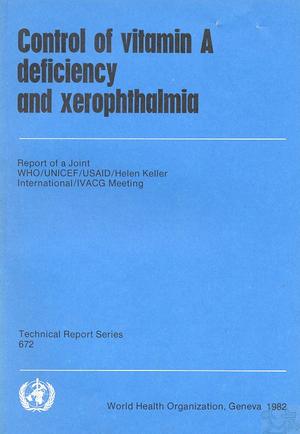Controlof vitamin A deficiency and xerophthalmia
İÇİNDEKİLERCONTENTS 1. Introduction ................................................ 1.1 Definitions .......................................... 2. Recent advances in the biochemistry of vitamin A and carotenoids . 2.1 The liver ............................................... 2.2 Control of retinol-binding protein (RBP) synthesis and release 2.3 Uptake of retinol by cells ................................. 2.4 Vitamin A and glycoprotein synthesis ...................... 2.5 Retinoids and cancer..................................... 2.6 Carotenoid determination in foodstuffs..................... 3. Interrelationships of vitamin A deficiency, protein-energy malnutrition and infections........................................................... 3.1 Vitamin A deficiency and PEM.................................... 3.1.1 Absorption of preformed vitamin A and B-carotene ............ 3.1.2 Retinol transport in plasma.................................. 3.2 Vitamin A deficiency and infections................................ 3.2.1 Vitamin A deficiency and the immune response ................ 3.2.2 Association of vitamin A deficiency and infections.............. 3.2.3 Effects of infections on vitamin A status ...................... 4. Assessment of vitamin A status........................................ 4.1 Clinical signs.................................................... 4.1.1 Ocular signs............................................... 4.1.2 Extraocular effects .......................................... 4.2 Biochemical data ................................................ 4.3 Dietary data .................................................... 4.4 Preliminary assessment........................................... 4.5 Prevalence surveys .............................................. 4.6 Prevalence criteria determining a vitamin A deficiency or xerophthalmia problem of public health significance ............................... 4.7 Surveillance .................................................... 5. Global occurrence of vitamin A deficiency and xerophthalmia ............. 5.1 Asia ........................................................... 5.1.1 Bangladesh ............................................... 5.1.2 China .................................................... 5.1.3 India ..................................................... 5.1.4 Indonesia ................................................. 5.1.5 Sri Lanka ................................................. 5.2 The Middle East ................................................ 5.3 Africa.......................................................... 5.3.1 Benin.................................................... 5.3.2 Ethiopia .................................................. 5.3.3 Kenya .................................................... 5.3.4 Malawi ................................................... 5.3.5 Mali...................................................... 5.3.6 Somalia................................................... 5.3.7 Sudan ....................................................5.3.8 United Republic of Cameroon ............................... 5.3.9 Upper Volta .............................................. 5.3.10 Zambia.................................................. 5.4 Latin America and the Carribbean................................. 5.4.1 Brazil .................................................... 5.4.2 Guatemala................................................ 5.4.3 Haiti..................................................... 6. Treatment and prophylaxis schedules.................................. 6.1 Treatment...................................................... 6.2 Prophylaxis ..................................................... 7. Control of vitamin A deficiency and xerophthalmia ...................... 7.1 Introduction .................................................... 7.2 Vitamin A interventions.......................................... 7.2.1 Periodic dosing ............................................ 7.2.2 Fortification............................................... 7.2.3 Educational programmes.................................... 7.2.4 Primary health care ........................................ 7.2.5 Nutritional rehabilitation programmes ........................ 7.2.6 Horticulture and related production activities .................. 7.3 Disaster relief................................................... 8. Research ........................................................... 8.1 Recent contributions............................................. 8.2 Priorities for future research ...................................... 8.2.1 Increasing vitamin A and provitamin A intake ................. 8.2.2 Epidemiological assessment ................................. 8.2.3 Determining the impact of a programme ...................... 8.2.4 Controlling the factors that impair vitamin A absorption and utilization................................................. 8.2.5 Controlling the ocular factors contributing to xerophthalmia ..... 9. References ......................................................... Annex 1. List of participants.............................................    |



